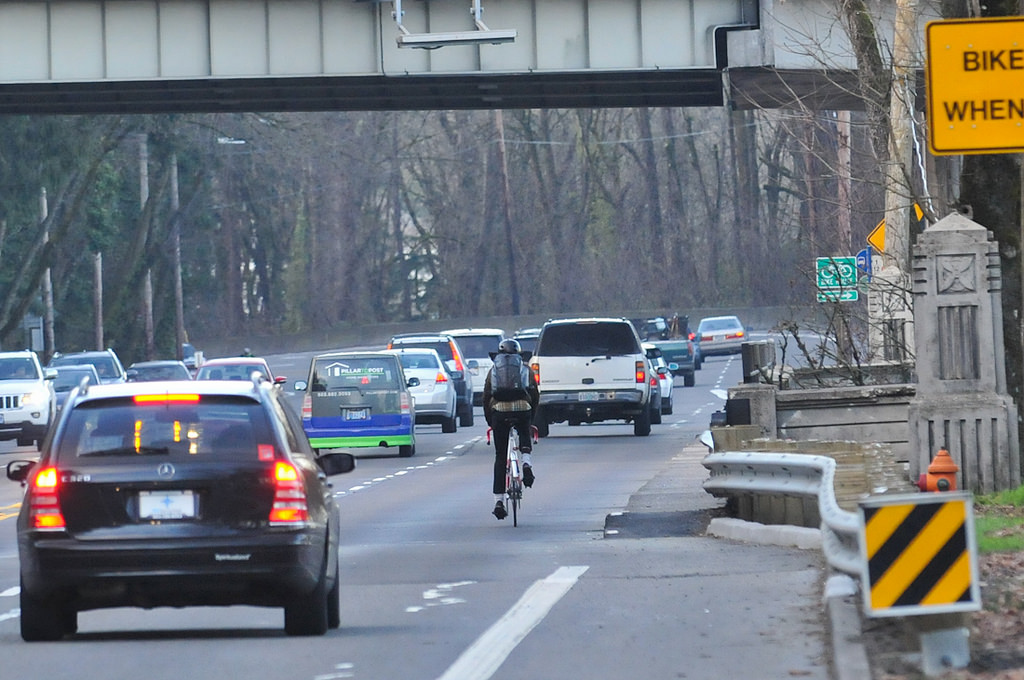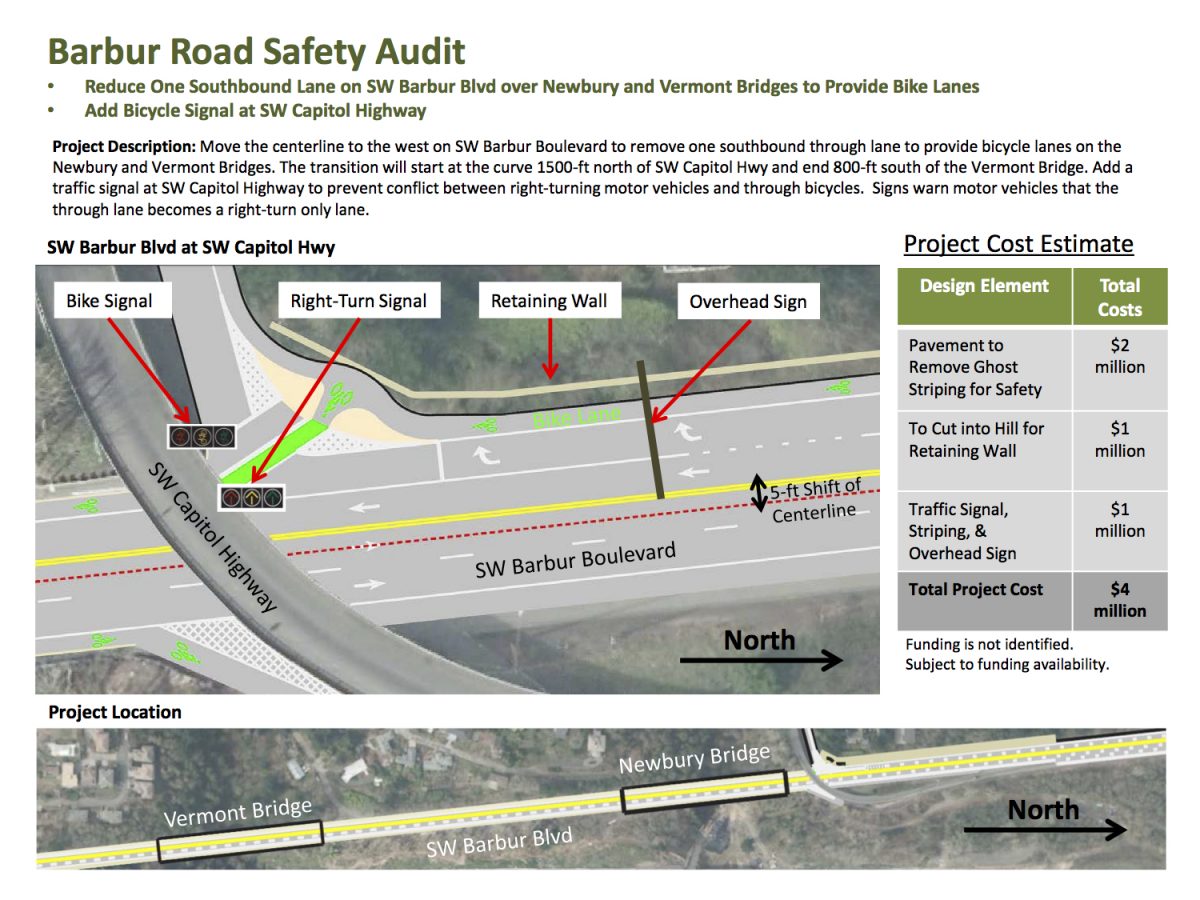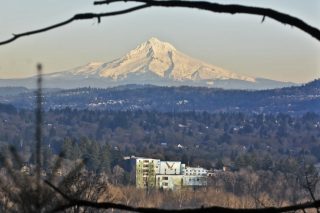
(Photo: Jonathan Maus/BikePortland)
This is the second part of a two-part article on Southwest Barbur Boulevard’s infrastructure needs by our SW Correspondent Lisa Caballero. Read part one here.
For years, much-needed changes to Barbur Blvd have been linked to building the SW Corridor light rail project, which would run along Barbur Blvd through its SW Portland segment. When voters rejected the Metro transportation funding measure in November, the light rail was left without a funding mechanism and safety improvements to Barbur have been in limbo.
Without support from the funding measure, TriMet has paused the light rail project and is completing its final Environmental Impact Statement to ensure it is, “eligible for future federal funding if the region identifies resources to restart the project.”
The need for safety improvements to Barbur, unfortunately, can’t be paused. With the SW corridor project stalled and its future uncertain, now seems like a good time to revisit ideas that were being discussed before the corridor’s future became bundled with the train.
Advertisement
This two-part series reviews a decade of advocacy, government studies and road improvements. Our first article examined the “diagonal” running from the Burlingame neighborhood south to the “Crossings” intersection with Capitol Highway. This article focuses on the northern section of Barbur, from “The Woods” into downtown.
The Woods and Bridges

(Photo: Jonathan Maus/BikePortland)
A decade ago, almost to the week, veteran southeast Portland bicycling advocate Keith Liden sent an email to the Oregon Department of Transportation. He had ideas about how to make the northern segment of Barbur Boulevard safer for people walking and riding bicycles.
With three northbound travel lanes into downtown, Barbur was oversized, he argued. The completion of I-5 nearly a half-century earlier meant the road no longer had to accommodate the regional and interstate traffic it once did. Barbur needed a road diet, starting with the Newbury bridge.
The Newbury and the Vermont bridges are in “the woods” segment of Barbur, and span deep ravines in the George Hines Park, to the west. Both Barbur Blvd and the bridges were completed in 1934 and were built on the recently deeded right-of-way of the Red Electric Train. At that time, Barbur ran from downtown Portland to the then western edge of the city, near SW Bertha Boulevard and the Burlingame Fred Meyer. A year later, the state completed Barbur’s southern extension along “the diagonal” to the Multnomah County boundary with Tigard. This county/city history explains the difference in character between the northern and southern segments that we still see today. The county section was built as a car-oriented business district, with motels, filling stations and restaurants. The northern “wooded” segment runs parallel to Terwilliger Blvd where city zoning prohibited commercial buildings and billboards.
Because of the steep topography and early zoning decisions, Barbur along “the woods” lacks cross streets, signals or businesses to create friction for the through traffic. This limited access results in the highest recorded speeds on the corridor.
The two bridges are the most perilous section of “the woods.” Each has four travel lanes, but lacks bike lanes or a safe pedestrian sidewalk. To use the bridges, cyclists must merge from an abruptly ending bike lane to take the right lane from cars which are speeding along between 45 and 55 mph (see top photo). This is extremely dangerous, and it prevents all but the most experienced cyclists from using Barbur.
Liden proposed merging northbound traffic from two lanes to one, just south of the Newbury Bridge, and re-establishing two travel lanes with the on-ramp of the Capitol Highway flyover. This reduced, three-lane cross-section over the bridge would make room for bike lanes in both directions. He added that this northbound lane reconfiguration should continue between Capitol Highway and Naito Pkwy, and that the off-ramp from northbound Barbur to Naito should be only one lane.
Advertisement
Liden wasn’t just any concerned activist, he had been on the advisory committee for the 1996 Portland Bicycle Master Plan, was a member of the Portland Bureau of Transportation Bicycle Advisory Committee from 1993 to 2019, and is a former member of the Metro Transportation Policy Alternatives Committee (TPAC).
ODOT responded to Liden several months later. In a detailed response, they explained why his suggestions were not feasible.
Although they acknowledged that “accommodation of bicycles on state highways is essential to multi-modal” and that “this highway is a vital connection point between north-south routes … many structures existing today were not constructed with the intentions of providing a 6-foot bike lane in either direction of travel.” ODOT’s litany of excuses included: Removing a lane would cause congestion for car users during peak traffic hours and could cause an increased number of crashes; Barbur capacity cannot be reduced as it is an alternate route to I-5 and a possible emergency evacuation route; and extra capacity was needed to accommodate future driving traffic demand.
Liden felt that ODOT wasn’t looking for solutions to the safety problems with an open mind. Exasperated, he stopped pursuing the idea.
The Battle is Engaged

Two years later, at the end of 2012, activists saw an opportunity to renew their calls for a road diet. ODOT was planning the Vermont/Newbury Bridge Preservation Project for retrofitting to prevent the bridges from becoming weight-restricted to trucks and TriMet buses (the project ended up also including safety elements such as a higher pedestrian safety railing, water drainage, and the installation of an automatically triggered “Bikes on Bridge” flashing beacon).
This led to an all-hands-on-deck advocacy push to include bike lanes with the project. Advocates included the Bicycle Transportation Alliance (now Street Trust), Oregon Walks, the City Club, neighborhood activists, PBOT’s Bicycle Advisory Committee, PBOT’s Bike Coordinator Roger Geller, the Lewis & Clark College Sustainability Council, and a new group named Friends of Barbur Blvd that emerged specifically to push this issue.
Advertisement
The lobbying effort was successful in that it prompted a direct response from ODOT to specific issues and forced the agency to collect additional traffic flow data during the four-month construction-required lane closures. That was a big win. Fast-forward a couple of years, ODOT completed the bridge repairs in the summer of 2014. It used the opportunity to conduct a traffic flow study during the naturally arising experiment of actual lane closures, and it released a traffic report in December 2014 which noted a 68% reduction in excessive speeding, no traffic diversion into neighboring streets and a more-than-predicted traffic delay.
One of the most interesting observations gleaned from the study is that about 40% of southbound Barbur traffic turns west onto Capitol Hwy. In other words, southbound Barbur traffic between Capitol Hwy and SW Miles is only 60% the volume of southbound traffic north of Capitol Hwy. This observation made a strong case that a southbound lane could be removed on the bridges without causing prohibitive congestion.
The demand for change continued to gain momentum when State Representative Ann Lininger pushed for the 2015 Barbur Road Safety Audit (which included designs for seven different bridge scenarios, four of which involved lane diets) and even Portland Transportation Commissioner Steve Novick and U.S. Congressman Earl Blumenauer called for action from ODOT. Finally, in 2016, ODOT acknowledged the need for a road diet, and offered a plan to remove one southbound lane from Barbur to allow for bike lanes over the bridges.
Advertisement
By 2017, the agency had produced a “Fact Sheet” which explained that ODOT had spent $8 million in the previous four years for Barbur safety improvements in Washington County and Portland, and it outlined upcoming work, including more detection loops at the Newbury and Vermont Bridges, bike lane restriping, and green bike boxes and signalling at Terwilliger — but there was no mention of a road diet.
The story doesn’t end there. Throughout this multi-year advocacy effort, ODOT’s responses often deferred to the developing Southwest Corridor Plan. Ultimately, in 2018, ODOT announced that they were intending to transfer jurisdiction of the bridges and Barbur Blvd to the City of Portland, and would contribute to rebuilding the bridges to accommodate the light rail.
Next Steps
The other thing that happened in 2018 is that a chunk of concrete fell off the Capitol Hwy fly-over, which required that Barbur lanes be reduced to one in each direction for repairs.

(Photo: Jonathan Maus/BikePortland)
Bike Activist Eric Wilhelm said that closure proved a point. “All they need is the willingness to implement a tactical road diet, like they did in July 2018 when absolutely no sky fell — except the bit of concrete which fell out of the BH/Capitol Hwy ramp).”
And Keith Liden hasn’t given up either. He recently emailed me to say, “Now that Southwest Corridor is stalled for at least a few years, it would appear to be a good time to revisit this, along with the Barbur/Naito intersection and downtown entry of Barbur onto SW Fourth Avenue.” He pointed out that making Barbur a great bike route between downtown and Burlingame doesn’t have to be expensive, it can involve paint and maybe some delineator wands and curbs.
If we can muster $9.5 million for the Flanders Crossing bridge over I-405, finding a fix to get bicycle riders through the “woods” without any scary surprises should be an easy lift.
— Lisa Caballero, lisacaballero853@gmail.com
— Get our headlines delivered to your inbox.
— Support this independent community media outlet with a one-time contribution or monthly subscription.





